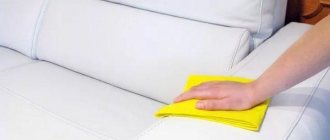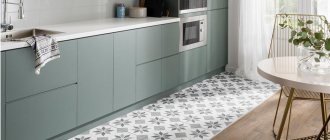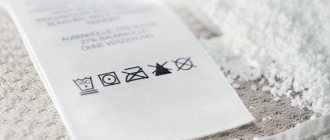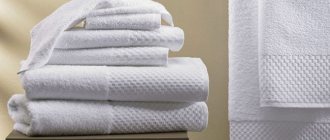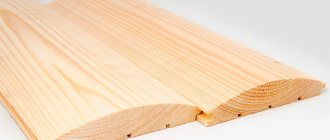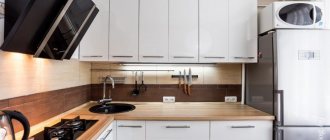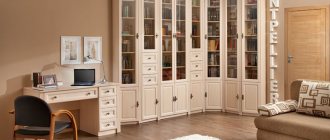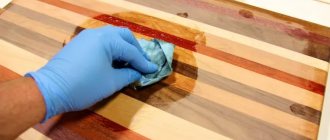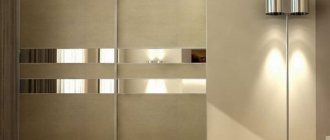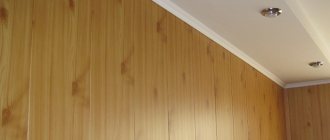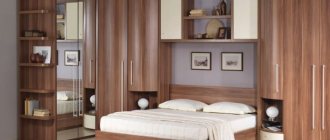The consequence of long-term use of a wooden house is the wood turning blue. The reason for the appearance of blue is certain types of fungus, which forms over time on the surface of an old wooden house, especially in cases where the wooden structure has not been periodically treated with protective agents. However, a healthy tree can have multi-colored spots if the natural pigment is unevenly distributed. Darkened and unevenly colored wood greatly spoils the appearance of the house; in addition, fungi can cause rot and destruction of the wood structure. An effective way to combat blue stains is to bleach wood. What means and how to whiten the walls of a wooden house will be discussed in the article.
Causes of fungus formation
Fungus and mold can develop on any wooden surface, regardless of lumber; even imitation timber and laminated veneer lumber are not immune to damage by microorganisms.
The type of wood also does not matter in this case; fungus can appear on both inexpensive pine and elite oak. A very common reason for the appearance of blue stains is improper transportation and violation of storage conditions of logs and timber. Lumber should be stored in a well-ventilated, dry place. It is advisable that the area is in the shade and that the tree is not exposed to precipitation.
Fungi that contribute to the formation of blue and gray plaque on wood develop very quickly, especially in suitable conditions. Therefore, you need to get rid of mold and mildew as soon as traces of their presence are discovered, especially in the bathhouse. This room creates the most favorable conditions for the proliferation of microorganisms - high temperature and high humidity, which significantly speed up the process.
What leads to a change in the natural color of wood
Destroys the color of wooden workpieces and microorganisms that develop on any material. It is quite possible to bleach blackened wood by finding out the causes of the stains. The lumber may become covered with blue or black spots. Durable wood can be susceptible to deterioration. Blackness can spread to pine and expensive oak.
Reasons for changing the color of wood include:
- errors during transportation;
- storage of lumber in unsuitable conditions;
- excessive lighting;
- storage in the rain;
- storage in an unventilated area.
Often, when carrying out repair work, it is necessary to remove stains from the workpiece. The technician will eliminate them, but if localized blackness remains, this will subsequently lead to the return of the mold.
Each type of wood has a characteristic color of the affected layer of material:
- oak becomes gilded;
- birch becomes covered with blue spots;
- dark ash becomes light;
- the nut takes on a bright red color.
The spread of microorganisms begins from small spots. Gradually the spots will grow and merge. If the affected surface is not treated, the process of damage to the wood will continue. It is necessary to cure blackened wood as quickly as possible.
Whitening products
Bleaching of logs is carried out using special bleaching agents, which are divided into two large groups:
- Chlorine-containing products. These include products containing: sodium or potassium hypochlorite, bleach, chlorine dioxide.
- Compositions without chlorine, in which the active substances are ammonia, hydrogen peroxide, oxalic acid and alkalis.
Any composition for bleaching wood operates on the same principle: it causes an oxidative process, as a result of which the coloring pigment becomes discolored and the fungal molecules are destroyed.
Subtleties of choosing and working with wood brighteners
The choice of means for lightening lumber depends on the degree of damage, as well as the type of wood. For example, chlorine-containing substances do not penetrate deep inside; they can only remove fresh, small-scale superficial stains.
- The treatment can be carried out even using household whitening.
- Alkaline compounds have a negative effect on the color of some types of wood.
- For example, oak wood will turn green as a result of processing.
- The best effect will be noticeable on light wood species.
In most cases, the substances used are toxic and require careful handling. Treatment is carried out with only one composition. Alternate use of different products or their combination is not permissible.
General recommendations for whitening
Before treating wood with bleaching agents, the surface must be sanded well. As a result of sanding, up to 20% of the blue stain is removed. In addition, bleach penetrates and is absorbed into the wood structure better if it is applied to sanded boards. So, the main recommendations:
- after bleaching, any composition must be washed off with water;
- acid-based bleach is washed off with an aqueous solution of soda;
- You cannot combine different compositions; the surface can only be treated with one product.
- if the wood is severely affected by fungus, it is necessary to treat it with a more concentrated composition.
- bleaching is most effective if it is carried out at a temperature of 18-20 degrees Celsius and at a humidity of about 60%;
- When processing wood inside the house, it is necessary to ensure ventilation of the room, because Almost all formulations contain components that are unsafe for health. If the treatment was carried out in a bathhouse, it is necessary to dry-heat the room twice before taking bath procedures to remove chlorine fumes.
Below you will learn how to whiten a log house after sanding.
How to clean boards from mold
There are two ways to clean boards from mold: call a specialized service that specializes in removing infected areas or get rid of the fungus yourself. If large-scale wood damage is detected, it is better to use the services of specialists. Since such companies determine the type of disputes and select the most effective means of destruction. In addition, processing is carried out with professional equipment.
If you decide to remove the fungus yourself, a person will need to prepare tools for the work and disinfectants that destroy mold spores.
Treatment with chlorine-containing agents
Wood can be bleached with bleach.
Before applying the product, it is necessary to remove the resin from the tree; to do this, the surface is treated with soda ash. Next, you need to dilute bleach with water in the following proportion: 2 kg of dry matter per bucket of liquid. Add 250 g of soda to the diluted solution, mix everything and let stand for a while. The product is applied with a brush or roller, and 5 minutes after treatment the surface is wiped with acetic acid. After about fifteen minutes, the wood should lighten. If the wood is not lightened enough, the procedure can be repeated.
Another chlorine-based bleach is bleach. It is especially effective for outdoor use. The wood is generously moistened with the liquid and then rubbed well into the surface. When using white, you must protect your eyes and hands from contact with the product.
Briefly about the main thing
Products that bleach wood surfaces are divided into chlorine and non-chlorine. The former cope better with fungi, the latter are more often used to restore the color of old wood. But they do not protect it from discoloration in the future. The wood may darken again from ultraviolet rays or wood-staining bacteria. To prevent this from happening, darkened structures need to be treated as early as possible, before the fungus goes deeper, then antiseptically carry out and a protective coating is applied.
Lightening wood with oxalic acid
Oxalic acid should be used with caution as it is very poisonous. Before applying the acid, the surface is treated with sodium hydrosulfite, and then almost immediately the wood is coated with a 10% solution of oxalic acid. After five minutes, both compositions are washed off with water.
Oxalic acid is well suited for bleaching light wood: maple, poplar, birch, linden. To achieve the desired effect, 6 ml of oxalic acid is diluted with 0.1 liter of water. The acid remaining on the wood is neutralized with the following composition: 15 g of bleach, 3 g of soda ash and 0.1 l of water. Then the wooden surface is washed with water.
Step-by-step removal of mold in wooden products
Elimination of consequences and prevention of further proliferation of fungal spores is carried out in several stages. How to remove mold from a wooden surface if the problem is found in a neglected state:
- Cleaning damaged areas. You will need a spatula and a chisel. Remove the top layers with a spatula. A chisel and knife are used if damage to the internal structure of the wood is detected.
- Dispose of all removed wood. It is advisable to burn all cut layers of wood.
- Washing the material. Prepare a concentrated solution of laundry soap and carefully treat cleaned wooden surfaces.
- After treatment with soapy water, the wood is allowed to dry. Then they are treated with a wood antiseptic. After disinfection, the wood is allowed to dry and the treatment of problem areas is repeated.
Industrial bleaches
Domestic and foreign industry today produces many effective and affordable products that can be used to whiten a log or timber house.
According to experts, one of the best bleaches is the Russian drug “Sagus”, which is used to prevent the formation of corrosion, and also effectively treats wood from fungus and whitens the surface.
Sagus not only lightens the wood, wood bleached with the product acquires an even shade, and black spots and spots disappear from it. The composition is resistant to weather conditions and humidity, so it can be used both inside and outside the house.
Another domestic product that is used to bleach wood is Neomid 500. It rids wood of fungus and mold, evens out the color, and also protects it from insects. For deep lesions, a concentrated composition is used. If there are only small pockets of fungus on the tree, the composition is diluted with water in a 1:1 ratio.
How to remove mold from wood
By attacking wood, mold spoils its aesthetic appearance. But the main danger of the fungus is not damage to property, but its negative impact on the human body. Spores can provoke an allergic reaction and even cause mycotic pathologies. If the damage is minor, you can remove mold from wood yourself, using antiseptics or improvised means.
What are the dangers of self-processing wood?
Home craftsmen, doing bleaching with their own hands, have very little idea of how complicated and dangerous this process is. All bleaching compounds are based on poisonous and toxic substances, which, if used incorrectly, can damage the surface and cause irreparable harm to health.
Non-professionals often incorrectly calculate the concentration of the product, violate the proportions, and do not include the necessary components in the composition, which negatively affects the wood.
It is necessary to strictly follow the technology of applying and rinsing off the product. The slightest violation of the technological process can lead to very sad consequences.
To avoid mistakes and prevent negative consequences, it is necessary to entrust bleaching of a wooden surface to specialists.
We employ professional craftsmen who know exactly the technology of wood bleaching and have successfully carried out this operation more than once.
If the walls of your wooden house are corroded by fungus, darkened and acquired a blue tint, contact our company. We will efficiently and quickly carry out all the necessary measures to whiten and renovate your home, which will again regain its lost beauty.
On the “Contacts” page you will find all our coordinates where you can contact us in a way convenient for you.
Calculate the cost of painting and insulating your home right now
Select types of work:
Select materials:
How to get rid of mold on a wooden surface
If the material is only slightly affected, the following will help get rid of mold:
- chisel and spatula;
- sandpaper;
- hammer;
- soft rags and fine sandpaper.
The scale of mechanical intervention depends on the depth of penetration of fungal spores. Sometimes it is enough to remove the thin top layer and then perform disinfection without severe damage to the timber.
Antiseptic
A properly selected chemical solution will destroy mold growth areas. As a rule, universal antiseptics and active fungicides are used for these purposes. The following have proven themselves well in the fight against disputes:
Important! Any chosen anti-mold product is used strictly according to the instructions. In addition to the recommended dosage, it is important to pay attention to the optimal temperatures at which processing is performed.
These antiseptics do not contain dangerous chlorine compounds and volatile toxins. At the same time, they are capable of not only destroying areas of bacterial growth, but also subsequently protecting the wood from spores. In addition, there are solutions that additionally have a toning effect. This allows the lumber to retain its natural appearance.
Folk remedies
Before treating the timber against fungus and mold using professional means, you can try traditional methods of combating it. Such means were successfully used for control even before special chemical solutions appeared on the construction market. Among the most popular are the following:
- Acetic acid. Lumber is treated with acetic acid in two stages. Spraying is performed for the first time. After complete drying, wipe again with a dampened rag. This method is completely safe, but gives a short-term effect.
- Hydrogen peroxide. Carefully treat the damaged areas with peroxide and leave for 15 minutes. Then clean the surface with a metal brush. The disadvantages include the risk of losing the appearance of the material.
- Baking soda. Add water to the soda and stir thoroughly until a thick paste is obtained. The product is applied to the damaged areas and left for 30 minutes. Then the surface is cleaned with a stiff brush.
- White. The most effective and most dangerous way to destroy mold fungi. Whiteness is applied to the areas where spores have been identified and left for 15 minutes. Wash off with soap concentrate.
Important! When planning to resort to folk remedies to combat mold, you should not use highly concentrated chlorine solutions. When using such products, you must wear a protective mask and rubber gloves.
Folk remedies are not always effective, and in some cases even dangerous to human health. Therefore, it is better to give preference to modern antifungal drugs with a multicomponent composition.
Methods for “healing” warped lumber
The first method to save wood building material is to treat it with disinfectant mixtures before darkening occurs.
When asked what to do if the boards become moldy, blue or blackened, there is only one answer: immediate treatment.
The method of action is as follows:
- Wood bleach treatment. Let's say the timber has darkened by 3-4 centimeters, this can be seen in the cross section. Bleach will help here, penetrating up to 5 cm deep.
- Treatment with a disinfectant that prevents the development of microbes in the body of the board.
How to prevent mold
After disinfection, it is important to take preventive measures. This will not only destroy all mold, but also prevent its occurrence in the future. The rules of prevention are not complicated and consist of the following steps:
- ensuring good air circulation;
- eliminating sources of high humidity. If the house has a basement, regular ventilation and heating will be required;
- maintaining stable temperature;
- annual treatment of wooden facades and finishing with a special antiseptic.
Private wooden houses are most susceptible to mold. Therefore, it is important to avoid mistakes when arranging ventilation, waterproofing and insulation. Since even with modern antiseptics, it is very difficult to completely remove mold. It is much easier to prevent it from appearing.
Construction of houses
Long-term use of wood most often ends with the appearance of blue stains on it. Especially if the tree is not periodically coated with special protective compounds. In this case, in order to avoid rotting of the wood, it is necessary to urgently take measures to bleach it. We’ll look at how to bleach a wooden frame yourself further.
Table of contents:
- How to bleach a log bathhouse: features and recommendations
- Prevention of appearance on wood: bleaching logs
- How to bleach the inside of a log house: means for bleaching a log house
- How to bleach a log house: work procedure
- How to bleach a log log - recommendations
- How to bleach a log house at home
How to bleach a log bathhouse: features and recommendations
The presence of fungi or algae on the surface of the tree causes it to become covered with a grayish coating. These microorganisms develop very quickly, especially inside the bathhouse, since this is where the conditions suitable for their reproduction are located: high humidity and high temperature. Therefore, if there are even the slightest spots of blue on a wooden frame in a bathhouse, you need to take care of bleaching.
After installing the log house, first of all, you should take preventive measures aimed at preventing the formation of mold on the surface of the wood. The main condition for its development is high humidity. Therefore, before installation, wood is treated with special protective compounds that prevent moisture from entering it. In addition, the room must have a high-quality ventilation system that allows you to get rid of excessive humidity when the bathhouse is not used for its intended purpose.
The outer part of the wood, located on the street, is also covered with special compounds, which must be renewed periodically. After all, it is affected by precipitation, sudden changes in temperature, moisture, wind, and solar radiation.
Most often, the reason for the appearance of mold on wooden surfaces is the fact that after the first coating with protective compounds, they are removed over time, and subsequent coating is not carried out. In this case, mold appears on the surface of the wood, without removing it, the wood very quickly rots and becomes unusable.
Another condition for the development of fungus inside the house is the presence of sunlight. If in the future the walls of the bathhouse are covered with panels or lining, then internal bleaching is not necessary. When covering wood with clear varnish, it is imperative to bleach it.
We suggest considering the option of bleaching the bath using a product called BIOSHIELD. With its help, it is possible to get rid of wood-staining fungi, various molds, and gray wood. After applying the composition, the wood acquires its original shade, without destroying its structure. This composition can be used to bleach almost any type of wood.
The duration of the drug is about ten years. The composition provides protection against the appearance of rot, fungus, insects, and algae. After applying the drug to the surface of the wood, its structure remains unchanged, while vapor permeability also remains at the same level.
There are preparations intended for interior and exterior decoration of buildings. Most often, the composition has a concentrated form, which can be changed in relation to the degree of damage to the tree.
Use a roller to apply antiseptic to the surface. Pigment paint, a few hours after applying the composition, begins to discolor. After the surface dries, salt may be released in crystalline form; use plain water to remove it.
If work is carried out indoors, make sure that it is well ventilated. The temperature for applying the composition outside should be from 0 to 20 degrees. One hundred to two hundred grams of material are consumed per square meter. If the fungus has affected the tree by more than three millimeters, it is recommended to cover it in several layers.
A newer and stronger version of BioShield is a composition called BIOShield2. With its help, it is possible to bleach almost any wood of the most advanced form of damage.
When applying bleach to a surface, use a stiff brush or roller, apply some force when applying the composition to the surface, and rub it in well. Thus, it will be possible to significantly increase the effectiveness of fungus removal.
Prevention of appearance on wood: bleaching logs
In order for the log house to serve you as long as possible, you must adhere to certain recommendations not only for its operation, but also for transporting the logs. Before transporting logs to the construction site, it is necessary to cover them with weak protective compounds; such protection will last them a little more than a week.
To prevent or slow down the development of fungus on logs, care should be taken to properly store lumber. Improperly stacked logs are an excellent place for fungus to grow. Therefore, at the installation site of the log house there must be stacks for ventilation. They must be installed on dry ground, in the shady part of the site. In addition, the presence of a special canopy should protect the tree from exposure to moisture. At the same time, additional ventilation between the logs is mandatory.
Preventive measures
In order for the tree to retain its attractiveness longer, it is very important to carry out preventive measures . They help protect wood from microorganisms. Dry wood should be coated with antiseptics. This way it will definitely not rot or become stained. After treatment with an antiseptic, the material must be dried.
Whatever the reason for the change in wood color, this problem can be dealt with in several ways. The main thing is to follow all the rules specified in the instructions.
To learn how to bleach wood, see the following video.
